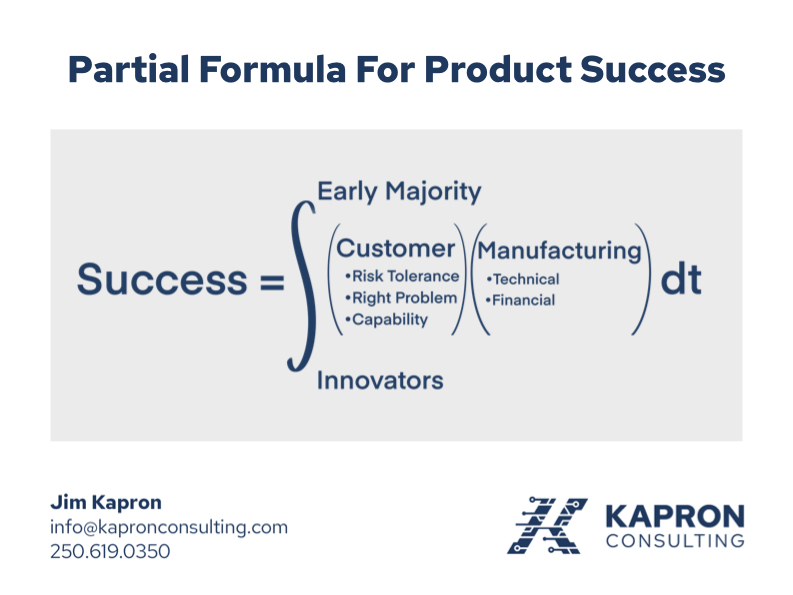Success of an Early-Stage Product
Learn how Kapron Consulting helped a start-up acquired by a Fortune 500 company develop a formula to successfully incorporate their early-stage product into the massive product line of their new parent company.
Problem
The start-up has been developing a product for five years. Your efforts for the last twelve months resulted in their first successful sales. Now, a Fortune 500 company found out what you've done and bought the start-up. You are the only one of the twenty employees that were seen to have value.
How do you take that early-stage product with so much promise, and incorporate it into their massive product line?
Solution
The answer is to develop a marketing plan.

Marketing
To some people, marketing is a bad word. To me, marketing has two essential components:
- Understanding the customer, and
- Understanding the manufacturer.
Understanding the Customer
To begin with we need to understand the customer's viewpoint:
- What do they do now?
Part of this is to choose the right customers, to make sure their skill set makes them capable of using the new technology well. - What can't they do now, but would like to do?
This is their application, and making sure that their problem can be solved by the new technology. - What can they not imagine doing, but would blow their socks off if they could?
This involves their tolerance for risk.
Understanding the Manufacturer
Understanding the manufacturer is a bit more complicated:
- Can they manufacture a reliable version of the start-up's product?
It sounds like a no-brainer, but don't ship marginal units. Sometimes, the urge to get products to customers outweighs the long-term interest in making sure that the product works in the hands of an early adopter. - Can their installation team convey confidence to the new customers?
Engineers need to be trained properly, especially if the new technology seems similar to existing ones. Effective training will prevent working products from being returned to the factory. - Can the application support team get the customer to generate the promised answers?
Sometimes, the application team discovers an old application from the early days of the start-up. It seems perfect, but the product has changed through the development process and the application is no longer valid. A well-trained application team doesn't need to call in the installation team to the customer site.
Marketing on the manufacturing side is also about:
- Convincing the R&D team that they should work towards the goal of the improved product.
- Convincing the accountants that it's worth the investment to improve the product. You would think that the behemoth's accountants would understand that already, but take nothing for granted.
- Convincing the manufacturing team that they can build it reliably, including:
- Drop test, stress tests
- Reproducibility
- Having exchange parts in stock
- Convincing the field repair team that they can work on it easily:
- Only the very occasional breakdown, with training and if the product is used correctly.
- With a trouble shooting guide. Basic setup errors represent >95% of errors with new technologies.
- Repairs involving return to factory result in lost confidence:
- Test before shipping
- Train before installation
- Communicate during installation
- Convincing the applications training team that they can explain the product well to the customer.
- Convincing the sales team that it will positively affect their bottom line, that the effort is worth it, and that every sale results in a happy customer.
Roadblocks to Success
If you're ever confronted with the question why some are successful and others not, then consider these reasons:
- Unreliability. If the product is truly not reliable, then it's a manufacturing reproducibility issue. There are a myriad of ways to address this.
- Lack of training. If it's due to insufficient training, this means your product is still beta. Take great care when choosing which type of customer to sell to, and which type of sales person takes care of that customer.
- Underdeveloped product. If the product requires great care and attention to detail to be successful, then you have an alpha product. It's still only for innovators and not ready for prime time.
One final thought: any consumable that is limited in supply, and causes a breakdown of the product, is a disaster waiting to happen. You need to address that issue before going to market.
Summary
Sales confidence comes from the ratio of one installation to one happy customer. The necessary bare minimum ingredients from the manufacturer are:
- Product quality: don't ship marginal units
- Engineer training for installation: you don’t want your product to be returned to the factory